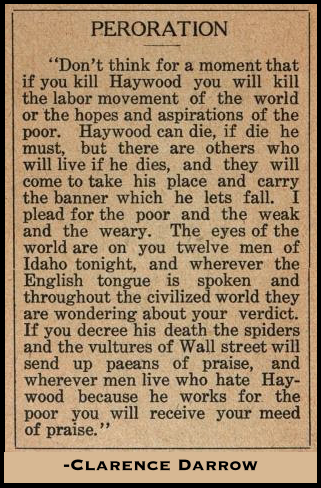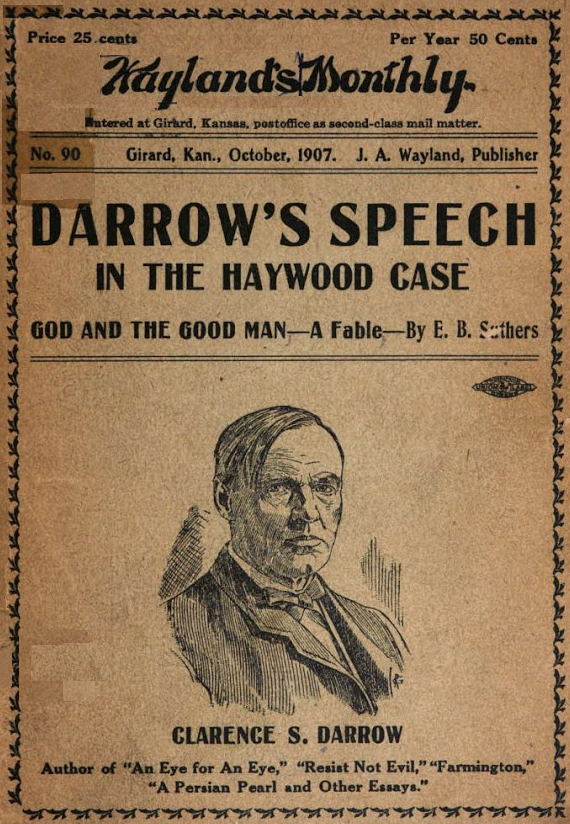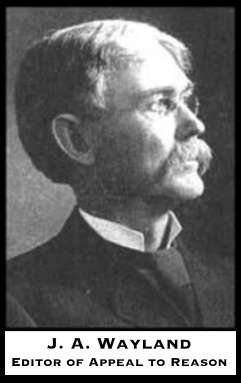
~~~~~~~~~~~~~~~~~~~~~~~~~~~~~~~~~~~~~~~~~~~~
Hellraisers Journal, Thursday October 3, 1907
Girard, Kansas – J. A. Wayland Publishes Darrow’s Greatest Speech
From Girard, Kansas, home of the Appeal to Reason, Socialist weekly, comes the publication of the entire speech made by Clarence Darrow on July 24th and 25th. This speech resulted in the famous “Not Guilty” verdict which was cheered by working men and women the world over.
From Wayland’s Monthly of October 1907:
—–
Darrow’s Speech is preceded by a “Note” which we believe was written by J. A. Wayland and provides a good summary of the Moyer-Haywood-Pettibone Case:
NOTE.
On December 30th 1905, at about seven o’clock in the evening, Frank Steunenberg was killed in Caldwell, Idaho, by the explosion of a dynamite bomb. Steunenberg had been the Governor of Idaho, and in 1899 had called the militia in the Coeur d’Alene district, in the northern part of the state, on account of the strike which was carried on by the Western Federation of Miners. After the militia was called out a bull-pen, or military prison, was established, and a large number of miners and their sympathizers were taken in custody and kept—many of them for several months. This military prison attracted widespread attention throughout the United and was the cause of an investigation by Congress. The action of Governor Steunenberg in establishing martial law and inaugurating the bull-pen was severely criticized by labor organizations and others at the time, and had been a common topic of discussion since.
Amongst the military prisoners was Jack Simpkins, then a prominent of the Western Federation of Miners, and afterwards and at the of the assassination of Steunenberg, one of the Executive Board of organization.
Governor Steunenberg had been a private citizen for a number of years, and was a banker in Caldwell, Idaho—a town of some three or four thousand people—which was his native home. Immediately after his death it was found that a dynamite bomb had been placed near his gate and a fish line attached to the gate and carried to the bomb in such a way as to explode the bomb by the opening of the gate. Governor Steunenberg, on returning to his home, shortly after dark, opened the gate and was almost instantly killed. His death caused the greatest excitement in Caldwell, in Idaho, and in fact throughout the country. Immediately after the explosion guards were placed around the town and every exit was patrolled every means taken to prevent anyone escaping from the place. A or two after Harry Orchard was arrested for the crime. Orchard had been in Caldwell at two different times in the last few weeks, and on this occasion had been staying at a hotel for upwards of a week. He seemed to have no business in the town, and some suspicious actions attracted attention to him and caused his arrest.
Jack Simpkins lived at the time in Spokane, Washington, about three or four hundred miles away, and had been at Caldwell with Orchard several weeks before, but was not there at the time of the explosion. After Orchard had been under arrest for several weeks he was taken to Boise and put in the State Penitentiary and turned over to James McPartland, the Western manager of the Pinkerton Detective Agency. A short time later he made a “confession,” in which he claimed that Charles H. Moyer, William D. Haywood and George E. Pettibone procured him to come to Idaho and commit the murder, and also that Jack Simpkins was connected with him and a party to it. At that time and since about 1901, Charles H. Moyer was President of the Western Federation of Miners— an organization covering the metal mines of the western country—and William D. Haywood was its secretary. George E. Pettibone was an old miner and a friend of the organization, but was not then connected with mining, and several years ago had been made an honorary member of the Western Federation. Jack Simpkins had for several years been a member of the Executive Board for the district in which Idaho was located.
Soon after Orchard’s arrest Jack Jack Simpkins disappeared. Moyer, Haywood and Pettibone were then living in Denver, Colorado, and it was not claimed that any one of them was present in Idaho at the time of or for a long time preceding the murder. Indictments were returned against Moyer, Haywood, Pettibone, Simpkins and Orchard.
The “confession” made by Orchard was kept secret for a number of weeks and a secret requisition was issued by the Governor of Idaho upon the Governor of Colorado. This was secretly honored and an order made by the Governor to turn the prisoners over to the authorities of Idaho. The prisoners were arrested about ten o’clock on a Saturday night, and denied access to or consultation with their friends or counsel. Along toward morning they were put on a special train which traversed the ten or twelve hundred miles between Denver and Boise at a high rate of speed, not stop ping at any cities or towns, but only at way stations and obscure places.
The whole proceedings were carried on in secret and by force, to prevent any appeal to the courts of Colorado to keep the men in that state. Under the laws of the country the men could be removed from one state to another only upon the theory that they were fugitives from justice from the state which demanded the prisoners for trial, and “a fugitive” has been repeatedly interpreted by the court as one who was bodily present at the commission of the crime and who ran away thereafter. This allegation was made in the affidavit of the County Attorney in Idaho as a basis for the requisition papers to be issued taking these men from Colorado. The allegation was made although everyone knew that neither Moyer, Haywood nor Pettibone had been present in Idaho for many months preceding the assassination of Steunenberg.
A writ of habeas corpus was applied for in Idaho and denied, and taken to the supreme court of the United States, based upon the theory that these men were illegally kidnaped and deprived of their liberty without due process of law. The Supreme Court of the United States held that so long as the men were being held in Idaho under indictments at the time the habeas corpus was applied for the court would not investigate the method by which they were brought into that state—that they were legally held at the time the writ was issued. To this opinion Justice McKenna filed a dissent, holding that so long as the men were deprived of any chance to appeal to any court in Colorado they had a right to make their application at the first opportunity that was given them, which was in the State of Idaho.
The case of Haywood, under the indictment for murder, was placed on the calendar first and came on for trial on the 9th day of May, 1907, and a verdict was returned in the last days of July. After twenty hours of deliberation a verdict of “Not Guilty” was reached.
The following is a stenographic report of the argument of July 24th and 25th, 1907. It contains many imperfections which are common to all verbatim reports of extended arguments. It, perhaps, should have been revised, but on the whole it was thought better to leave it with its imperfections than attempt to change it.
[Photograph of J. A. Wayland added.]
SOURCE
Wayland’s Monthly
(Girard, Kansas)
-Oct 1907
(Also source for images of magazine.)
https://play.google.com/books/reader?id=DQEiAQAAMAAJ&printsec=frontcover&output=reader&hl=en&pg=GBS.PP5
Note by JA Wayland
https://play.google.com/books/reader?id=DQEiAQAAMAAJ&printsec=frontcover&output=reader&hl=en&pg=GBS.PA1
Also here:
http://moses.law.umn.edu/darrow/documents/Darrow_Speech_Haywood_Case.pdf
And here:
https://babel.hathitrust.org/cgi/pt?id=umn.31951002129627p;view=2up;seq=4
IMAGE
J. A. Wayland, ed AtR, 1895-1912
http://spartacus-educational.com/USAwaylandJ.htm



